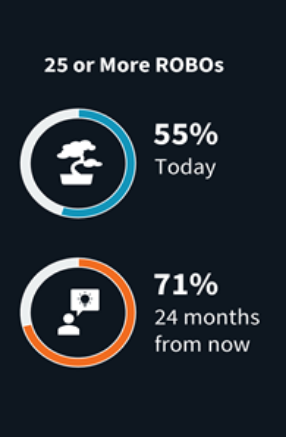
Brought to you by:
Enterprise Strategy Group | Getting to the Bigger Truth™
ESG WHITE PAPER
Flexible SD-WAN Consumption Model
A Simple, Secure, Cost-effective Way to Purchase and Use SD-WAN
By Bob Laliberte, Principal Analyst; and Leah Matuson, Research Analyst
APRIL 2022
Modern Environments are Highly Distributed and Dynamic
Figure 1. Public Cloud Adoption Has Become Ubiquitous
Does your organization currently use public cloud services (SaaS, IaaS)? (Percent of respondents, N=706)
Of all the business applications used by your organization, approximately what percentage is currently public cloud-resident? How do you expect this to change – if at all – over the next 36 months? (Percent of respondents, N=706)
Source: ESG, a division of TechTarget, Inc.
Figure 2. The Trend Toward Increased Hybrid Work
To the best of your knowledge, what is the current breakdown of how your employees work and what do you expect that percentage to be in 24 months, under the assumption that all COVID-related work-from-home government mandates are lifted? (Mean, N=613)
Source: ESG, a division of TechTarget, Inc.

Nearly Three-quarters of Organizations Expect to Support at Least 25 Remote Office or Branch Office (ROBO) Locations in the Next 24 Months.
Legacy SD-WAN Solutions Provide Certain Benefits, But Have Limitations
Figure 3. Organizations Plan to Procure SD-WAN Solutions Through a Mix of Channel Preferences
How does your organization plan to procure most of its SD-WAN solutions today? (Percent of respondents, N=454)
Source: ESG, a division of TechTarget, Inc.
Transformation to a Consumption-based Model is Underway
54% of survey respondents indicated that they are shifting to a consumption-based model for data center infrastructure.
Figure 4. Applying Cloud Consumption Model to Data Center Infrastructure Continues to Gain Momentum
Assuming the net-costs were the same, which of the following do you believe would be your organization's preferred payment model for on-premises data center infrastructure? (Percent of respondents)
Source: ESG, a division of TechTarget, Inc.
Palo Alto Networks Offers Prisma SD-WAN Bandwidth Licensing On-demand
The Bigger Truth
This ESG White Paper was commissioned by Palo Alto Networks and is distributed under license from TechTarget, Inc.
All trademark names are property of their respective companies. Information contained in this publication has been obtained by sources The Enterprise Strategy Group (ESG) considers to be reliable but is not warranted by ESG. This publication may contain opinions of ESG, which are subject to change from time to time. This publication is copyrighted by The Enterprise Strategy Group, Inc. Any reproduction or redistribution of this publication, in whole or in part, whether in hard-copy format, electronically, or otherwise to persons not authorized to receive it, without the express consent of The Enterprise Strategy Group, Inc., is in violation of U.S. copyright law and will be subject to an action for civil damages and, if applicable, criminal prosecution. Should you have any questions, please contact ESG Client Relations at 508.482.0188.

Enterprise Strategy Group | Getting to the Bigger Truth™
Enterprise Strategy Group is an IT analyst, research, validation, and strategy firm that provides market intelligence and actionable insight to the global IT community.
